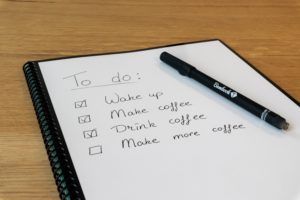There are so many reasons you might want to self-study maybe you want to learn a subject for fun, maybe, you want to learn a topic to get ahead for a class next year, or prepare yourself with some foundational knowledge for another class you have coming up. Regardless, this post will break down all of the steps for you to self-study a subject or self-study for an exam.
Step 1: It is to find a reliable textbook or book resource:
The hardest part about self-studying is that you don’t know what you need to know. It’s an unknown. So, finding a very comprehensive text resource will help you set up a framework for your DIY course, essentially, the table of contents of this textbook is like your syllabus; It’ll tell you the topics you need to know and what level of depth you need to understand them at for AP exams. This tends to be a prep book like the Barron’s or Princeton Review books or maybe a textbook regardless of what subject or book you choose you must do your research to find the most comprehensive resource about the topic that you’re learning. I recommend looking at reviews online for what your best option would be, especially, if these reviews come from a teacher or professor or another expert in the subject area. The one thing that I want to point out is to make sure there are practice tests or review questions or practice examples included in your text because practice questions that come from an official source, not just those that you write yourself are invaluable when it comes to studying.
In this post, I’m going to be using AP US government and politics class as an example for the self-studying topic. I got this Barron’s AP gov prep book from the library and I want to point out that as I mentioned it has two full practice tests and lots of practice questions it helps to have one main resource for that one table of contents.
That you’re going to mostly base you’re studying framework on but having an additional resource can provide more detail to the topics that you’re going to cover through your main resource, for example, it can corroborate the main resource as to what information will be the most important for you to know like what are the main ideas the big ideas that you have to know, and it can offer some extra support in covering those areas that may be that first main resource missed. These supplementary resources might also explain the topics in a different way that might make more sense to you and the way that you understand concepts or process information. Some examples might be videos that are available on Khan Academy, or some more books if that’s in your realm of financial possibilities, or you can borrow notes from someone else who previously took that class or self-study.
Step 2: It is to use the resources to set up your framework:
There are two main places that you want to skim for one; the table of contents, of course, which will give an overall list of all the topics being covered. Flip through the book and see how the patient goes between all of these different topics when you’re doing that skimming through of the book, the questions that you want to think about that table of contents are:
1- Whether some topics are covered in much more depth than others?
2- Whether some topics are just glossed over generally if something is talked about more in that book; it means it’s a more fundamental important concept to that subject area or a topic that is covered more often on the AP exam or any other exam you’re studying for.
Be sure to also check with those supplementary resources you got to keep an eye out for any topics that may be your main framework or textbook either just didn’t include or didn’t find to be particularly important and see if the way the topics in similar ways do all of your resources we agree that certain topics are more important? Or is there a more uneven balancing of what each resource finds to be the most important? It’s not that any one of the resources is more correct it’s just important to keep an eye out for all of this stuff so you can get as much information as you can after you’ve got the bigger picture idea of what topics are being covered and which ones are the most important.
It is time to concretely start writing down what topics you plan to study, so this is like writing your syllabus but then you also need to divide out these larger topics into smaller lessons. The way that I recommend you do this is to write out the title of each section, for example, each numbered chapter in a peak of prep book is going to be each of my lessons in the prep book that I’m using as the example all of the sections are already approximately equal at about 20 pages each.
However, chapter one is pretty short. I would combine it with chapter two or, for example, if maybe one of the chapters ended up being 50 pages, I might divide it into say chapter 4 first 25 pages and chapter 4 last 25 pages. Be sure to also write down any extra topics that aren’t covered in your main resource but may be covered in some of your supplementary resources.
Step 3: You’ve got this list of lessons to schedule them all out:
Start by counting out exactly how long your study timeline is. If you don’t have an exam you’re studying for, you’ll just set up your deadline maybe that’ll be the end of summer brick or something just pick a deadline then once you know that timeframe divide that up into units of the time these are like the Buckets you’ll put lessons into this can be a week a day probably, no less than a day or more than a week. If I’m going, to be honest maybe you would assign yourself three lessons for one week or maybe you want to assign yourself one lesson every two days it’s really up to you. In my opinion, a weekly schedule works best because a day to day schedule is just a little hard to manage especially if there’s a lot of variability in the amount of work that your teachers assign each day.
A weekly schedule would allow you to shuffle around the work to the days you have the least work to do but, of course, this will vary based on your personal productivity style and how your weekly cycles tend to go, and how consistent they are. Be sure to also reserve an appropriate timeframe as your buffer zone between when you finish your entire curriculum and when your exam comes. This is like a built-in dead week for you to review I would personally spend most of the time doing full-length practice tests or maybe just relaxing and catching up on sleep for optimal mental performance on that day of the exam. Now, once you know the exact number of time buckets you have, and the exact number of lessons that you have; it’s time to divide them equally into those time buckets.
Step 4: It is to execute you’ve properly paced yourself out for all of these topics that you have to cover:
Now, the question is how do you cover these topics? here is the method that I found works best for me and that I think will probably work for most people but, of course, feel free to modify. You know yourself and your way of studying too. Habits are the best, so trust yourself. The first step would be to read, to get that information in my brain if you find anything confusing, be sure to check out your supplementary resources or do some googling to learn and fully understand the information. For example, if I’m reading my preparation book and I find a section is confusing, I might look for a crash course video on YouTube about it.
Memory has multiple Levels. First, you encode the information into your brain and then eventually you have to learn how to recall it how to actually pull that knowledge out of your brain and not just be able to recognize it or look at it. There are two basic levels of learning how to remember things. The first one is a simple factory call for me the best technique for factory recall like remembering what a vocabulary word means or memorizing a formula is to use flashcards, but, once again, you know yourself and your study habits. Second, the level of remembering is to not just be able to recall basic facts but to be able to do more higher-level analytical style thinking.
In addition to those facts for those, I recommend doing practice tests. It’s honestly quite difficult to do this without having questions already written for you by an expert who already knows everything about this topic so that’s the reason that I recommended finding a textbook resource that already has questions included and you could also go online and find example final exams that professors have uploaded and especially if you’re so you can get used to the style of questions that they ask.
An important aspect of doing the studying part is getting feedback. it’s good to do all of this practice stuff but you don’t want to practice and perfect your method of getting to the wrong answer which is why you need feedback for multiple-choice questions or maybe math questions where there’s only one right answer. This can be as simple as checking your answers in the answer key at the back of your textbook. For more ambiguous work, you’ll need to check with someone who’s a little bit more knowledgeable about the topic maybe there’s a teacher at your school who’s teaching this or a friend who has already taken the class and did well.
Finally, It’s really hard to motivate yourself to self-study even more difficult than motivating yourself to do work for a class just because there isn’t very much outside accountability. No one’s out there to force you to do anything; you have to force yourself to do everything which is very difficult. The first step you did of scheduling out a clear plan will make it much easier for you to get it done because you know you’ve cleared out that path for you and made it easy to follow. You need to just follow it and yes that does make the ascent a lot easier than it is.






One Response
Great Topic and great article. Nice job 👍 !